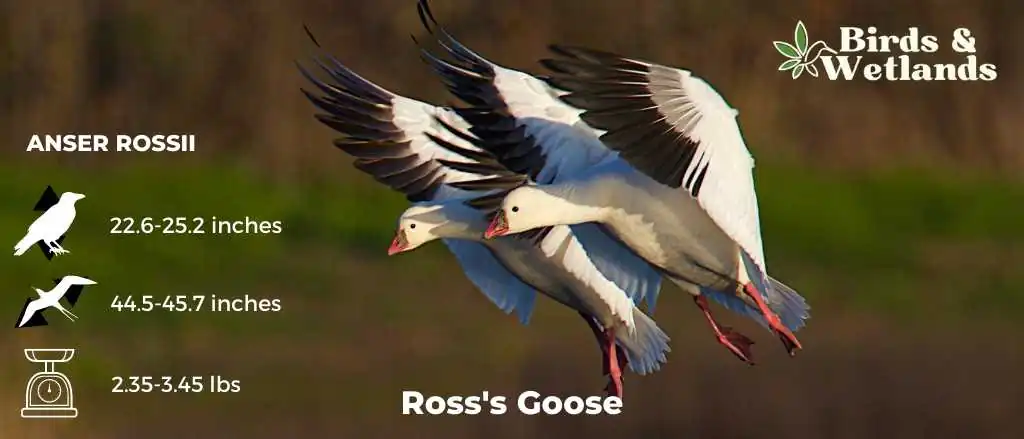Ross’s goose is the smallest of the white geese that breed in North America. It is a pure white goose with black wingtips and a short neck. It shares many characteristics with the snow geese, including the two color phases or morphs — white and blue phases.
Scientific Name: Anser rossii
Height: Male: 23.2-25.2 in (59–64 cm) / Female: 22.6-24.4 in (57.3–62 cm)
Wingspan: 44.5-45.7 in (113–116 cm)
Weight: Male: 42.3-55.3 oz (1198-1567 g) / Female: 37.6–51.3 oz (1066–1454 g)
Ross’s Goose Description
Adult White Morph
An adult white morph of Ross’s goose is a small, all-white goose with black wingtips and pink legs. Its stubby pink bill has a bluish-gray base, which helps to distinguish it from other whitish waterfowl more commonly found in its habitat.
Like the rest of Ross’s goose population, white morphs are active year-round and typically migrate between Canada and California.
Despite their conspicuous appearance, they are quite difficult to spot in the wild due to their shy and wary nature.
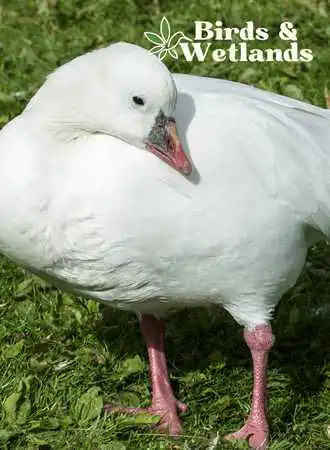
Adult Blue Morph
Adult blue morphs of Ross’s geese are distinctive, with very dark gray plumage that evokes the color of stormy skies. This starkly contrasts with their white head and neck and the new white feathering on their upper wings.
A characteristic feature of this morph is the striking pattern on its dorsal side; here, a mix of black and silvery-gray feathers creates a mesmerizing pattern that is quite unlike any other goose species.
It is important to note that the adult blue morph of Ross’s goose is extremely rare. And when it does happen, it looks similar to the blue morph geese of the snow geese species, only smaller.
Juveniles are mostly white with a gray tinge and a dark bill.
Additionally, Ross’s geese interbreed with Snow geese and resulting in offspring with the appearance of Ross’s goose but a black grin patch and curved bill of the blue goose.
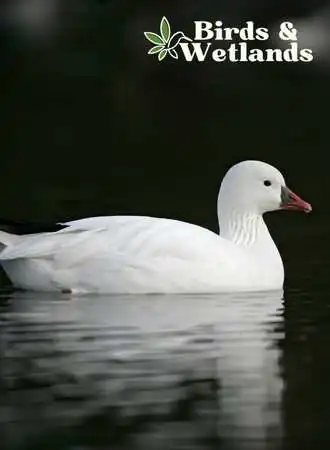
Listen to Ross’s Goose
Ross’s Goose Habitat
Ross’s geese live and breed in the vast Arctic landscape, characterized by flat plains with scattered patches of vegetation and wetlands. This habitat offers the geese plenty of space to forage for food and a range of wetland habitats to choose from when it comes time to seek shelter and build nests.
Additionally, the absence of trees or tall shrubs in this environment means that there is little risk of predation and interference from other animals.
Ross’s Goose Diet
The Ross’s Goose is a goose that feeds primarily on plant material. This includes sedges and green grasses, typically a variety of plants with stiff, narrow blades and short stems. The geese usually feed on the roots at the beginning of the breeding season and switch to new shoots as they emerge.
However, the geese feed mostly on seeds and grains during their autumn migration. This can include wild grasses and cultivated crops, with the geese feeding on areas like harvested sunflower fields or wheat paddocks.
Adult white morphs often flock with other species of geese while feeding corn and other grains on agricultural fields
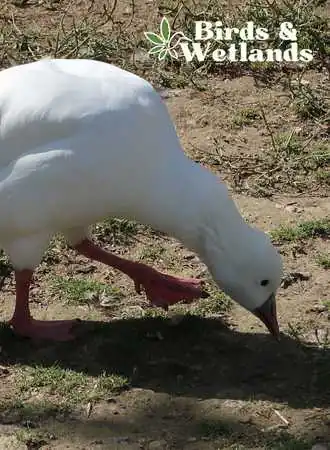
Ross’s Goose Range

Ross’s goose breeds throughout the northern regions of Canada, usually near the Arctic. The breeding range of Ross’s goose extends to parts of Alaska, including northern portions such as Nome and Prudhoe Bay.
Ross’s geese are known for their impressive migratory habits, traveling vast distances yearly to escape colder temperatures in the winter. These magnificent birds typically travel through the Central and Mississippi Flyways, where they join up with other flocks to form large groups.
In addition, some of these geese also journey to the Pacific and Atlantic Flyways, often traversing thousands of miles of open ocean along the way.
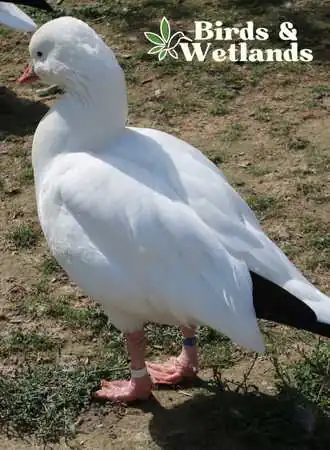
Ross’s Goose Nesting & Mating
The nesting and mating habits of Ross’s goose are unique and fascinating. These geese typically form monogamous pair bonds, establishing a nest site on small islands or along the shore of lakes in Arctic tundra habitats when they arrive during spring migration.
The nests are usually constructed in low shrubs or amongst the roots of small trees and may be used from one season to the next. Because these geese breed alongside large populations of Snow Geese, it is not uncommon for them to build their colonies within Snow Goose breeding grounds. Snow geese breed between late May to mid-August.
Female Ross’s geese typically choose to construct their nests on the ground, where they have access to plentiful materials for construction. This normally involves a mix of twigs, leaves, grasses, and moss meticulously arranged into a sturdy bowl shape. The nest is then lined with soft down feathers to cushion the eggs once they have been laid.
Although many other bird species start to build their nests immediately after mating, female geese may continue adding to their nests even after beginning the process of incubating their eggs.
Females lay up to six eggs and incubate for 21 to 23 days.

Ross’s Goose Population & Conservation
Despite legal hunting in some parts of its wintering range, the population of Ross’s Geese has increased significantly over the past few decades, thanks to the protect habitat approach. The current evaluation status of Ross’s Goose is Least Concern.
Hunting
Hunting of Ross’s geese is legal in many states but is subject to federal and state waterfowl hunting regulations.
Key Takeaways
The ross goose and lesser snow goose were previously thought of as similar species but they are separate species with distinct differences such as a shorter neck, stubby bill, lack of grinning patch and a more rounded head.
Ross’s goose is slightly larger than a Mallard but smaller than a Canada goose.
Ross’s goose has two color morphs — white phase and dark phase.
Most Ross’s geese are white but others can come in dark morphs similar to blue geese.
Both color phases have pink bills.

